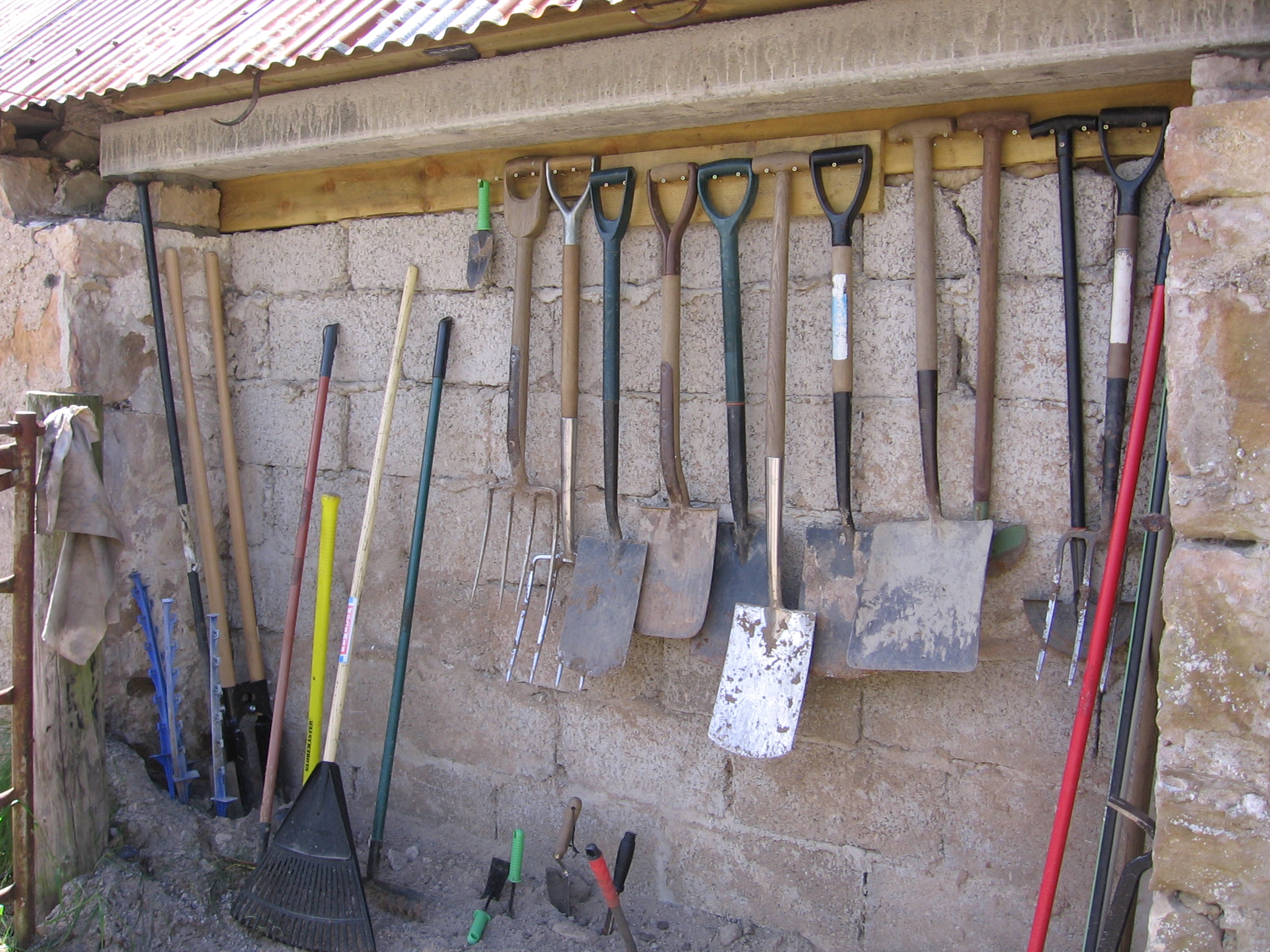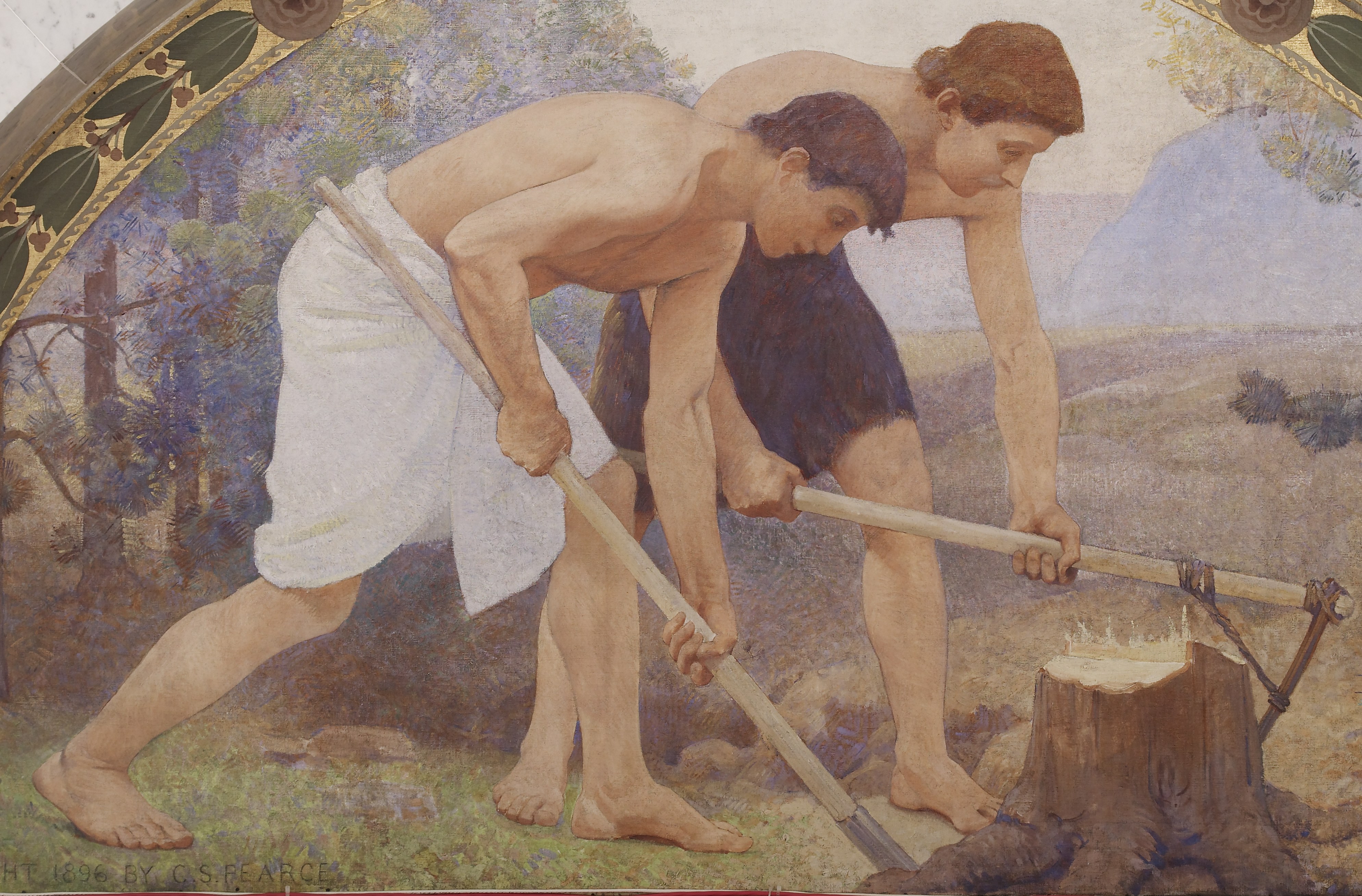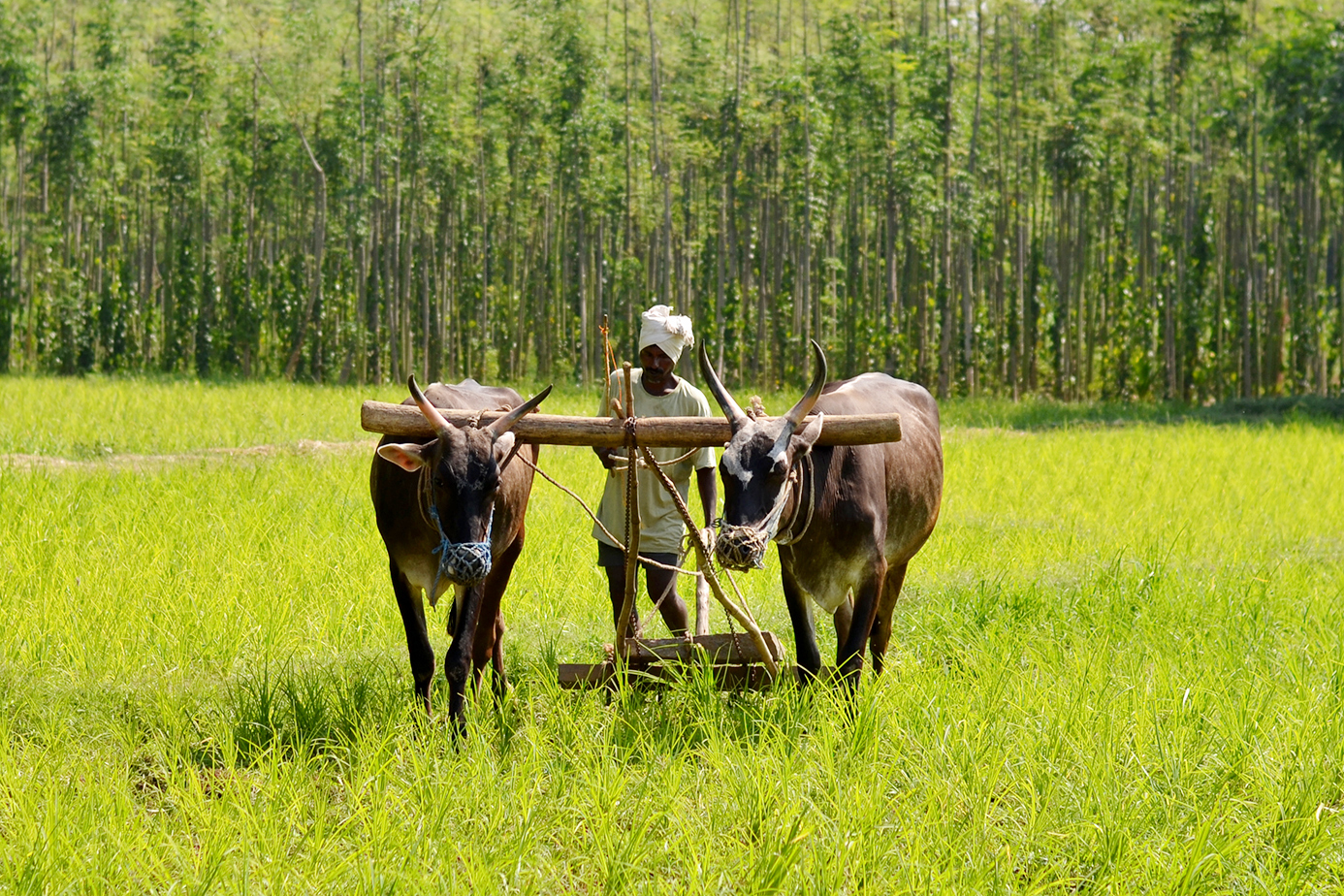|
Rototiller
A cultivator is a piece of agricultural equipment used for secondary tillage. One sense of the name refers to frames with ''teeth'' (also called ''shanks'') that pierce the soil as they are dragged through it linearly. It also refers to machines that use rotary motion of disks or teeth to accomplish a similar result. The rotary tiller is a principal example. Cultivators stir and pulverize the soil, either before planting (to aerate the soil and prepare a smooth, loose seedbed) or after the crop has begun growing (to kill weeds—controlled disturbance of the topsoil close to the crop plants kills the surrounding weeds by uprooting them, burying their leaves to disrupt their photosynthesis, or a combination of both). Unlike a harrow, which disturbs the entire surface of the soil, cultivators are designed to disturb the soil in careful patterns, sparing the crop plants but disrupting the weeds. Cultivators of the toothed type are often similar in form to chisel plows, but t ... [...More Info...] [...Related Items...] OR: [Wikipedia] [Google] [Baidu] |
Two-wheel Tractor
Two-wheel tractor or walking tractor (french: motoculteur, russian: мотоблок (motoblok), german: Einachsschlepper) are generic terms understood in the US and in parts of Europe to represent a single-axle tractor, which is a tractor with one axle, self-powered and self-propelled, which can pull and power various farm implements such as a trailer, cultivator or harrow, a plough, or various seeders and harvesters. The operator usually walks behind it or rides the implement being towed. Similar terms are mistakenly applied to the household rotary tiller or power tiller; although these may be wheeled and/or self-propelled, they are not tailored for towing implements. A two-wheeled tractor specializes in pulling any of numerous types of implements, whereas rotary tillers specialize in soil tillage with their dedicated digging tools. This article concerns two-wheeled tractors as distinguished from such tillers. Definition Research has identified a number of terms used to ... [...More Info...] [...Related Items...] OR: [Wikipedia] [Google] [Baidu] |
Tractor
A tractor is an engineering vehicle specifically designed to deliver a high tractive effort (or torque) at slow speeds, for the purposes of hauling a trailer or machinery such as that used in agriculture, mining or construction. Most commonly, the term is used to describe a farm vehicle that provides the power and traction to mechanize agricultural tasks, especially (and originally) tillage, and now many more. Agricultural implements may be towed behind or mounted on the tractor, and the tractor may also provide a source of power if the implement is mechanised. Etymology The word ''tractor'' was taken from Latin, being the agent noun of ''trahere'' "to pull". The first recorded use of the word meaning "an engine or vehicle for pulling wagons or plows" occurred in 1896, from the earlier term " traction motor" (1859). National variations In the UK, Ireland, Australia, India, Spain, Argentina, Slovenia, Serbia, Croatia, the Netherlands, and Germany, the word "tractor" ... [...More Info...] [...Related Items...] OR: [Wikipedia] [Google] [Baidu] |
Garden Tool
A garden tool is any one of many tools made for gardening and landscaping, which overlap with the range of tools made for agriculture and horticulture. Garden tools can be divided into hand tools and power tools. Hand tools Today's garden tools originated with the earliest agricultural implements used by humans. Examples include the hatchet, axe, sickle, scythe, pitchfork, spade, shovel, trowel, hoe, fork, and rake. In some places, the machete is common. The earliest tools were made variously of wood, flint, metal, tin, and bone. The development of metalworking, first in copper and later in bronze, iron, and steel, produced today's durable tools, including such efficient cutting tools as pruning shears (secateurs – for example anvil pruners), grass shears, and loppers. Increasing use of modern alloys allows many tools to be made both stronger and lighter, making them more durable and easier to use. Ergonomics Some modern tool designs reflect ergonomic considerations, ... [...More Info...] [...Related Items...] OR: [Wikipedia] [Google] [Baidu] |
Hardpan
In soil science, agriculture and gardening, hardpan or soil pan is a dense layer of soil, usually found below the uppermost topsoil layer. There are different types of hardpan, all sharing the general characteristic of being a distinct soil layer that is largely impervious to water. Some hardpans are formed by deposits in the soil that fuse and bind the soil particles. These deposits can range from dissolved silica to matrices formed from iron oxides and calcium carbonate. Others are man-made, such as hardpan formed by compaction from repeated plowing, particularly with moldboard plows, or by heavy traffic or pollution. Formations Soil structure strongly affects its tendency to form a hard pan. One such common soil condition related to hardpan is soil pH. Acidic soils are most often affected due to the propensity of certain mineral salts, most notably iron and calcium, to form hard complexes with soil particles under acidic conditions. Another major determinant is the soil par ... [...More Info...] [...Related Items...] OR: [Wikipedia] [Google] [Baidu] |
Industrial Revolution
The Industrial Revolution was the transition to new manufacturing processes in Great Britain, continental Europe, and the United States, that occurred during the period from around 1760 to about 1820–1840. This transition included going from hand production methods to machines, new chemical manufacturing and iron production processes, the increasing use of steam power and water power, the development of machine tools and the rise of the mechanized factory system. Output greatly increased, and a result was an unprecedented rise in population and in the rate of population growth. Textiles were the dominant industry of the Industrial Revolution in terms of employment, value of output and capital invested. The textile industry was also the first to use modern production methods. The Industrial Revolution began in Great Britain, and many of the technological and architectural innovations were of British origin. By the mid-18th century, Britain was the world's leadi ... [...More Info...] [...Related Items...] OR: [Wikipedia] [Google] [Baidu] |
Working Animal
A working animal is an animal, usually domesticated, that is kept by humans and trained to perform tasks instead of being slaughtered to harvest animal products. Some are used for their physical strength (e.g. oxen and draft horses) or for transportation (e.g. riding horses and camels), while others are service animals trained to execute certain specialized tasks (e.g. hunting and guide dogs, messenger pigeons and fishing cormorants). They may also be used for milking or herding. Some, at the end of their working lives, may also be used for meat or other products such as leather. The history of working animals may predate agriculture, with dogs used by our hunter-gatherer ancestors. Around the world, millions of animals work in relationship with their owners. Domesticated species are often bred for different uses and conditions, especially horses and working dogs. Working animals are usually raised on farms, though some are still captured from the wild, such as do ... [...More Info...] [...Related Items...] OR: [Wikipedia] [Google] [Baidu] |
Manual Labour
Manual labour (in Commonwealth English, manual labor in American English) or manual work is physical work done by humans, in contrast to labour by machines and working animals. It is most literally work done with the hands (the word ''manual'' coming from the Latin word for hand) and, by figurative extension, it is work done with any of the muscles and bones of the human body. For most of human prehistory and history, manual labour and its close cousin, animal labour, have been the primary ways that physical work has been accomplished. Mechanisation and automation, which reduce the need for human and animal labour in production, have existed for centuries, but it was only starting in the 18th and 19th centuries that they began to significantly expand and to change human culture. To be implemented, they require that sufficient technology exist and that its capital costs be justified by the amount of future wages that they will obviate. Semi-automation is an alternative ... [...More Info...] [...Related Items...] OR: [Wikipedia] [Google] [Baidu] |
Mattock
A mattock is a hand tool used for digging, prying, and chopping. Similar to the pickaxe, it has a long handle and a stout head which combines either a vertical axe blade with a horizontal adze (cutter mattock), or a pick and an adze (pick mattock). A cutter mattock is similar to a Pulaski used in fighting fires. It is also commonly known in North America as a "grub axe". Description A mattock has a shaft, typically made of wood, which is long. The head consists of two ends, opposite each other and separated by a central eye. A mattock head typically weighs . The form of the head determines the kind and uses of the mattock: * A ''cutter mattock'' combines the functions of an axe and adze, with its axe blade oriented vertically and longer adze horizontally. * A ''pick mattock'' combines the function of a pick and adze, with a pointed end opposite an adze blade. Both are used for grubbing in hard soils and rocky terrain, with the pick mattock having the advantage of a supe ... [...More Info...] [...Related Items...] OR: [Wikipedia] [Google] [Baidu] |
Hoe (tool)
A hoe is an ancient and versatile agricultural and horticultural hand tool used to shape soil, remove weeds, clear soil, and harvest root crops. Shaping the soil includes piling soil around the base of plants (hilling), digging narrow furrows ( drills) and shallow trenches for planting seeds or bulbs. Weeding with a hoe includes agitating the surface of the soil or cutting foliage from roots, and clearing the soil of old roots and crop residues. Hoes for digging and moving soil are used to harvest root crops such as potatoes. Types There are many kinds of hoes of varied appearances and purposes. Some offer multiple functions while others have only a singular and specific purpose. There are two general types of hoe: draw hoes for shaping soil and scuffle hoes for weeding and aerating soil. A draw hoe has a blade set at approximately a right angle to the shaft. The user chops into the ground and then pulls (draws) the blade towards them. Altering the angle of the handl ... [...More Info...] [...Related Items...] OR: [Wikipedia] [Google] [Baidu] |
Working Animal
A working animal is an animal, usually domesticated, that is kept by humans and trained to perform tasks instead of being slaughtered to harvest animal products. Some are used for their physical strength (e.g. oxen and draft horses) or for transportation (e.g. riding horses and camels), while others are service animals trained to execute certain specialized tasks (e.g. hunting and guide dogs, messenger pigeons and fishing cormorants). They may also be used for milking or herding. Some, at the end of their working lives, may also be used for meat or other products such as leather. The history of working animals may predate agriculture, with dogs used by our hunter-gatherer ancestors. Around the world, millions of animals work in relationship with their owners. Domesticated species are often bred for different uses and conditions, especially horses and working dogs. Working animals are usually raised on farms, though some are still captured from the wild, such as do ... [...More Info...] [...Related Items...] OR: [Wikipedia] [Google] [Baidu] |
Drawbar (haulage)
A drawbar is a solid coupling between a hauling vehicle and its hauled load. Drawbars are in common use with rail transport, road trailers, both large and small, industrial and recreational, and with agricultural equipment. Agriculture and horse-drawn vehicles Agricultural equipment is hauled by a tractor mounted drawbar. Specialist agricultural tools such as ploughs are attached to specialist drawbars which have functions in addition to transmitting tractive force. This was partly made redundant with Ferguson's development of the 3 point linkage in his famous TE20. A wooden ''drawbar'' extends from the front of a wagon, cart, chariot or other horse-drawn vehicles to between the horses. A steel ''drawbar'' attaches a three-point hitch or other farm implement to a tractor. Road A drawbar is a towing or pushing connection between a tractive vehicle and its load. Light vehicles On light vehicles, the most common coupling is an A-frame drawbar coupled to a 1 7/8 inch or 50 ... [...More Info...] [...Related Items...] OR: [Wikipedia] [Google] [Baidu] |









